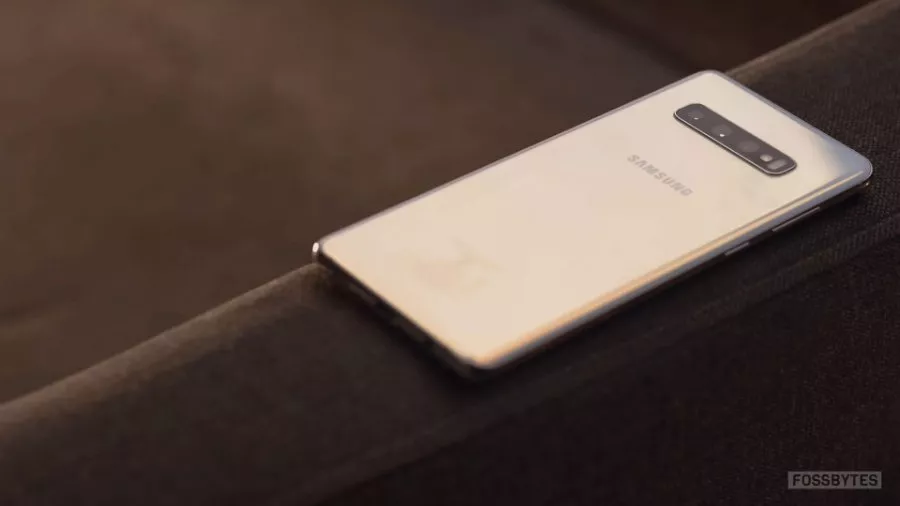Samsung Galaxy S10+ Review: The Good, The Bad, And The Worst

Samsung has been trying to strengthen its place in the premium smartphone market. The Galaxy S9 and the Galaxy Note 9 were decent, however, they were quickly forgotten in the continuous battle between the Pixel and iPhone.
With the all-new Samsung Galaxy S10 Plus, it is safe to say that Samsung has finally crossed the bridge and has a device that people can look up to.
Technically it’s not a single device — the Samsung Galaxy S10 comes in three variants: The Galaxy S10E which directly competes with the iPhone XR, the Galaxy S10 which is the middle child nobody cares about, and the Galaxy S10 Plus which we have with us right now
Samsung Galaxy S10+ is one of the best smartphones right now right off the bat. I am probably nit-picking at this point, however, there are a few things which could have been better.
Before painting it all bad and give you the wrong idea, let’s start with the good things first —
The Good
Design and Build
In regard to aesthetics, Samsung Galaxy S10 Plus is definitely a ten-by-ten. It is one of the most recognizable Samsung devices so far. The Galaxy S10 Plus (Prism white) has a shiny pearl-like finish on the glass back, which results in glittering prismatic colors.
The best part is the Galaxy S10’s overall build. While it gives reminiscence of a bulkier phone, the device is extremely light weighing just 175g. On the contrary, the Google Pixel 3 XL and the iPhone XS Max weighs around 185g and 208g, respectively.
Thankfully, Samsung has kept the headphone jack with the Galaxy S10 series. It’s interesting how Samsung released Galaxy Buds, the true wireless earbuds, and retained the headphone jack, which isn’t the case with most smartphone makers right now.
Display
The Galaxy S10 Plus is the first phone to feature HDR 10+ Dynamic OLED display. The panel shows a wide range of color tones and makes scenes realistic like never before. Due to the curved edges and fewer bezels on the sides, the large display takes the viewing experience to an entirely new level.
The Samsung Galaxy S10+ has a 6.4-inch display with a 1440 x 3040 resolution, making it extremely sharp. Owning to HDR 10+ technology, the panel is brighter than the IPhone XS, OnePlus 6T, Galaxy Note 9, and most smartphones right now. And similar to the previous Samsung devices, you can tone down the colors under the display settings.
OS
The Samsung S10 comes with Android Pie-based One UI which is remarkably better than our general conception of the Samsung OS.
First and foremost, the user-interface is extremely smooth. Of course, one of the underlying reason is the Snapdragon 855, coupled with 8GB RAM which can go up to 12GB, depending upon the variant.
But aside from this, the UX is highly user-friendly as well, sometimes, even more than the stock Android Pie. It’s amazing to see how elegantly the One UI blends in with the S10+ big display. As one would notice, all the major elements have shifted downwards for easy access.
I also liked the system-wide dark mode on the OneUI, unlike the half-cooked in Google Pixel. Talking about Pixel, the Android Q first Beta is out and Samsung track record with updating devices is not quite right. So, let’s how that turns out.
Meanwhile, the Bixby button is still here. However, it’s less annoying because you can remap Bixby to two taps, instead of one. You can also re-map the Bixby button to open other apps, excluding 3rd party assistant apps.
Battery
Last but not least, the Samsung Galaxy S10 Plus comes with a gigantic 4100 mAh battery. It gives plenty of juice before you can use the fast charger again.
The best part with the S10 bold claims of “all-day-long battery” is genuine. The device does give a full day battery, even with few high power consumption bursts.
The Bad
Punch-hole
The Samsung Galaxy S10 series comes with Infinity-O display and O stands for the hole punch cut out on the top edge. I think it is less intrusive than the previous notches we have seen in other smartphones.
Nevertheless, it is still a notch. Despite shifting little to the right and separating from the edge, it tends to get in my way. You can hide the notch by going into the display settings. However, it results in an eye-soaring black bar that turns the display unattractive.
Additionally, it is ironic how Samsung is advocating a cut-out, when, in fact, it trolled Apple of having a notch on the first place. The laser cut pill-shaped notch on the Samsung Galaxy S10+ pannel is a new approach to deliver edge-to-edge display, but it also tells us notches aren’t going anywhere.
Camera
Let’s talk about that camera module for a moment — The S10 Plus comes with triple camera setup: A 12MP primary wide lens with f/1.5-2.4; a 12 MP Telephoto lens with f/2.4; and a 16MP ultra-wide lens with f/2.2.
As you’d notice, the only “unique” thing in the camera is the new ultra-wide lens. Since the other two were also present in the Galaxy S9 and Galaxy Note 9, photos are not much different from the last generation.
Another addition to the camera is the 4K video recordings from the front camera as well as the back camera. Talking about the front camera, there is a 10 MP primary camera, coupled with an 8MP depth sensor.
The back camera clicks good pictures, however, it loses to iPhone XS on many instances as the iPhone generates more natural tones. On the other hand, Samsung keeps on adding more light which results in losing some of the natural colors.



Honestly, I liked the front camera more than the triple-cam setup on the back. Mostly, I was impressed with the live focus aka portrait mode shots.
Coming to the rear camera, the major takeaway is the new ultra-wide lens which you won’t find in a Pixel or an iPhone. Moreover, it comes with some stunning images.
Reverse Wireless Charging
Along with the Samsung Galaxy S10, the company also introduced the Galaxy Buds which many are saying is the anti-AirPods because it is so amazing. However, the interesting part is that you can use the reverse wireless changing to change Galaxy Buds or any device that supports reverse wireless charging.
Personally, I haven’t tested charging the buds but one thing I can say it’s definitely not suitable for charging other phones because obviously, there is no sense to it, at least, not right now.
In-display Fingerprint
Now, the notch isn’t the only thing we have under the huge display. The Galaxy S10 comes with one of the first ultrasonic in-display fingerprint sensors. For those who don’t know, an ultrasonic fingerprint sensor is different from the optical sensors, particularly the screen doesn’t brighten up when unlocking the phone.
There are many advantages of having an ultrasonic fingerprint reader over the optical one as it works even when the screen is off. Also, it works even when the fingers are wet or covered in oil or dirt.
Presently, the S10s in-display fingerprint sensor is relatively slower than the OnePlus’s optical one. However, the major problem is the small contact area on the S10 devices. Because of which, one tends to frequently miss the in-display spot.
The Worst
This brings me to the worst part of the Samsung Galaxy S10 that is the overall unlocking system. As I mentioned earlier, the in-display does not have a good success rate and it is a lot slower than the capacitive ones.
The power button is placed little too high which makes it extremely difficult to reach it. Moreover, Samsung Galaxy S10 is a large device which makes it a little difficult to use
So, the final alternative is the face unlock. For some reason, Samsung put a low-grade face unlock in the Galaxy S10 Plus. Apparently, one can unlock the screen with a photo of your face. On top of that, I faced the same situation in the Samsung Galaxy M20: A budget smartphone which I reviewed a few days ago. It’s safe to assume that Samsung is using the same face unlock of that of a $150 smartphone.
The All-rounder?
Before I conclude, the Samsung Galaxy S10+ 128GB variant with 8GB RAM is priced at $999. However, you can also go for the 512GB variant or the 1 TB variant, coupled with 12GB RAM for which you’ll have to additionally pay $600.
Overall, there are a few things that could have been better but that does not overshadow the awesome features of the Samsung Galaxy S10 Plus.
Also Read: Samsung Galaxy M20 Review: Can It Be The New Budget King?





















